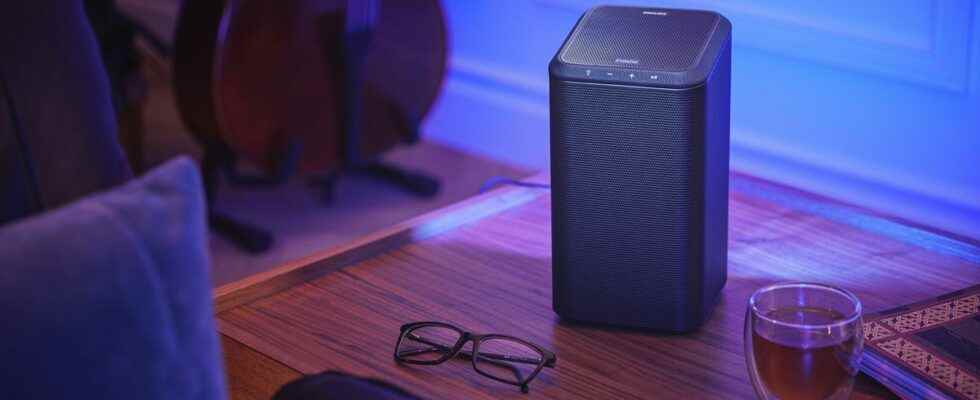No major change at Philips / TP Vision, at least not in its home cinema audio range. The manufacturer has just presented 5 new products ready to match its new range of OLED+ televisions.
On the program: a connected and surround speaker from the Fidelio range, and 4 sound bars of various orientations.
Fidelio FS1: a connected speaker, stereo, surround, or Atmos
With a fairly sober but visibly luxurious design (use of leather and aluminium), the FS1 is a fairly high-end speaker. Indeed, this model is based on a three-way audio architecture, consisting of a 9 cm bass driver supported by 2 passive radiators, a 6.3 cm midrange transducer facing upwards (Atmos channel) and a 25mm tweeter.
The big plus of the device is to rely on the connected/Multiroom DTS Play-Fi protocol. Thanks to this, the FS1 can work as a standalone, but also in stereo configuration with a second loudspeaker and a compatible Ambilight TV, or even as a rear speaker, in a Surround/Atmos configuration. Philips is obviously thinking of pairing with the future FB1 soundbar as well as with the FW1 subwoofer. In addition, the Fidelio FS1 has an LED strip, capable of extending the Ambilight effect of compatible Philips TVs.
The FS1 will be available in October for 329.99 euros each. As a reminder, the FB1 soundbar will be released this month for 899.99 euros, and the FW1 subwoofer is already available for 549.99 euros.
4 soundbars for all uses
Less high-end than the Fidelio sets, the 4 soundbars (with subwoofer) announced can be divided into two groups.
Higher end of the lot, the B8907 and B8507 are respectively references 3.1.2 (8 transducers, including 2 vertical) and 3.1 (6 transducers) with DTS Play-Fi integration. Therefore, they are connected and compatible with FS1 type rear speakers. Also, both bars are Bluetooth 5.3, giving hope for LE Audio compatibility. Both include an eARC socket.
In terms of power, the B8907 develops no less than 720 W, against 600 W for the B8507.
For their part, the B7807 and B7207 are 3.1 and 2.1 soundbars that are not DTS Play-Fi compatible and generally not connected. The B7807 is technically very similar to the B8507, as it retains the same audio architecture, equivalent power and the integration of an HDMI eARC socket, all with Dolby Atmos support. Less ambitious, the small B7207 has only 4 speakers, is only Dolby Digital compatible and is limited to HDMI ARC connectors, not eARC. It is therefore a kind of entry/mid-range a little higher than the current B6405. Announced for the month of November, these soundbars do not yet have an official price.
Source: Philips press release

1